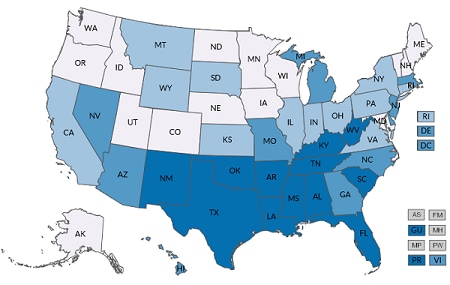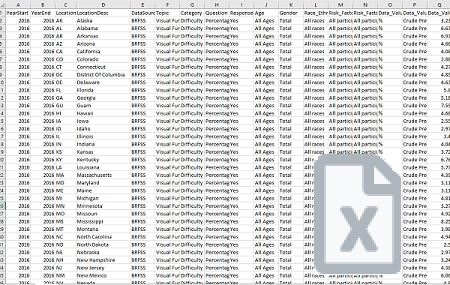National Health Interview Survey
NHIS at a Glance
| National Health Interview Survey | |
|---|---|
| Description | In-person interview survey |
| Sample | Sample of households that are nationally representative of the US population |
| VEHSS Topics Included |
|
| Approximate Size | Approximately 87,500 people per year |
The National Health Interview Survey (NHIS) monitors the health of the United States population through the collection and analysis of data on a broad range of health topics. The survey has been conducted since 1957, and since 1960 has been conducted by National Center for Health Statistics (NCHS), a center of CDC. NHIS data are used widely by the Department of Health and Human Services (DHHS) and the public health research community to monitor trends in illness and disability and to track progress toward achieving national health objectives.
NHIS provides indicators on vision services, impacts of vision on activities of daily living, and use of precautionary eye protection. VEHSS estimated the prevalence rate and sample size from NHIS public use data files. The prevalence rate was defined as the number of people who gave an affirmative response to the question, divided by the total number of respondents who gave an affirmative or negative response, and multiplied by 100 for presentation in percentage format. Estimates with high uncertainty are suppressed. To increase sample size, multiple years of NHIS data were merged for analysis.
NHIS Variables analyzed in VEHSS
| VEHSS Topic – Category | VEHSS Indicator | NHANES Variable | NHIS Question Text | Sample |
|---|---|---|---|---|
| Vision Care Services | Percentage of children whose family members talked to an optometrist, optician, or eye doctor (someone who prescribes eyeglasses) about the child’s health | CHCSYR1_2 | DURING THE PAST 12 MONTHS, has anyone in the family seen or talked to any of the following health care providers about [fill2: alias]’s health? An optometrist, ophthalmologist, or eye doctor (someone who prescribes eyeglasses)? |
Children >2 years |
| Vision Care Services | Percentage of children who wear eyeglasses or contact lenses | CVISGLAS | Does [NAME] wear eyeglasses or contact lenses? | Children 6-17 years who are not blind |
| Vision Care Services | Percentage of children (ages 6-17) who participate in sports, hobbies, or other activities that can cause eye injury | CVISACT | Does [NAME] participate in sports, hobbies, or other activities that can cause eye injury? This includes activities such as baseball, basketball, soccer and mowing the lawn. | Children 6-17 years |
| Vision Care Services | Percentage of children (ages 6-17) who participate in sports, hobbies, or other activities that can cause eye injury that wear eye protection | CVISPROT | When doing these activities, on average, does [he/she] wear eye protection always, most of the time, some of the time, or none of the time? | Children 6-17 years who said YES to CVISACT |
| Diabetic Retinopathy (DR) | Percentage of adults ever told by a doctor or other health professional they had diabetic retinopathy | VIM_DREV | Have you EVER been told by a doctor or other health professional that you had diabetic retinopathy? | Adults 18+ |
| Cataract | Percentage of adults ever told by a doctor or other health professional they had cataracts | VIM_CAEV | Have you EVER been told by a doctor or other health professional that you had cataracts? | Adults 18+ |
| Cataract | Percentage of people with diagnosed cataract who had treatment | VIMCSURG | Have you ever had cataract surgery? | Adults 18+ who said Yes to VIM_CAEV |
| Glaucoma | Percentage of adults ever told by a doctor or other health professional they had glaucoma | VIM_GLEV | Have you EVER been told by a doctor or other health professional that you had glaucoma | Adults 18+ |
| Age-related Macular Degeneration (AMD) | Percentage of adults ever told by a doctor or other health professional they had macular degeneration | VIM_MDEV | Have you EVER been told by a doctor or other health professional that you had macular degeneration? | Adults 18+ |
| Vision Care Services | Percentage of adults who currently wear eyeglasses or contact lenses | VIMGLASS | Do you currently wear eyeglasses or contact lenses? | Adults 18+ who report they are not blind or unable to see at all |
| Vision Problems and Blindness | Percentage of adults who even when wearing glasses or contact lenses find it difficult to read ordinary print in newspapers | AVDF_NWS | Even when wearing glasses or contacts lenses, because of your eyesight, / Fill 2: Because of your eyesight,] how difficult is it for youto read ordinary print in newspapers | Adults 18+ who report they are not blind or unable to see at all |
| Vision Problems and Blindness | Percentage of adults who when wearing glasses or contact lenses find it difficult to do work or hobbies that require them to see well up close | AVDF_CLS | Even when wearing glasses or contacts lenses, because of your eyesight, / Fill 2: Because of your eyesight,] how difficult is it for you to do work or hobbies require you to see well up close such as cooking, sewing, fixing things around the house or using hand tools | Adults 18+ who report they are not blind or unable to see at all |
| Vision Problems and Blindness | Percentage of adults who even when wearing glasses or contact lenses find it difficult to go down steps, stairs, or curbs in dim light or at night | AVDF_NIT | Even when wearing glasses or contacts lenses, because of your eyesight, / Fill 2: Because of your eyesight,] how difficult is it for you to go down steps, stairs, or curbs in dim light or at night | Adults 18+ who report they are not blind or unable to see at all |
| Vision Problems and Blindness | Percentage of adults who even when wearing glasses or contact lenses find it difficult to find something on a crowded shelf | AVDF_CRD | Even when wearing glasses or contacts lenses, because of your eyesight, / Fill 2: Because of your eyesight, ] how difficult is it for you to find something on a crowded shelf | Adults 18+ who report they are not blind or unable to see at all |
| Vision Problems and Blindness | Percentage of adults who even when wearing glasses or contact lenses find it difficult to drive during daytime in familiar places | AVDF_DRV | Even when wearing glasses or contacts lenses, because of your eyesight, / Fill 2: Because of your eyesight,] how difficult is it for you to drive during daytime in familiar places | Adults 18+ who report they are not blind or unable to see at all |
| Vision Problems and Blindness | Percentage of adults who even when wearing glasses or contact lenses find it difficult to notice objects off to the side | AVDF_PER | Even when wearing glasses or contacts lenses, because of your eyesight, / Fill 2: Because of your eyesight,] how difficult is it for you to notice objects off to the side while you are walking along | Adults 18+ who report they are not blind or unable to see at all |
| Vision Care Services | Percentage of adults who participate in sports, hobbies, or other activities that can cause eye injury outside of work | AVISACT | Outside of work, do you participate in sports, hobbies, or other activities that can cause eye injury? This includes activities such as baseball, basketball, mowing the lawn, wood working, or working with chemicals. | Adults 18+ |
| Vision Care Services | Proportion of adults who participate in activities which may cause injury that wear eye protection | AVISPROT | When doing these activities, on average, do you wear eye protection always, most of the time, some of the time, or none of the time? | Adults 18+ who said Yes to AVISACT |
| Vision Care Services | Percentage of adults who in the past 12 months have seen or talked to an optometrist, optician, or eye doctor (someone who prescribes eyeglasses) about their own health | AHCSYR2 | DURING THE PAST 12 MONTHS, have you seen or talked to any of the following health care providers about your own health? …An optometrist, ophthalmologist or eye doctor (someone who prescribes eyeglasses). |
Adults 18+ |
| Vision Problems and Blindness | Percentage of people who have (no, some, a lot) difficulty seeing even when wearing glasses | VIS_SS22 | Do you have difficulty seeing, even when wearing glasses? | Adults 18+ who were asked the family disability questions (FDB) and were randomly selected to receive the Functioning and Disability (AFD) section |
| Vision Care Services | Percentage of people who wear glasses (NHIS Functioning and Disability Module) | VIS_02 | Do you wear glasses? | Adults 18+ who were asked the family disability questions (FDB) and were randomly selected to receive the Functioning and Disability (AFD) section |
Available Geographic Levels
| National |
|---|
| Included Stratification Factors (State and National Estimates) | |
|---|---|
| Age Group |
|
| Gender |
|
| Race/Ethnicity |
|
| Risk Factors |
|
| Data Type |
|
A detailed description of the analytical steps is described in the report “VEHSS Survey Analysis Plan pdf icon [PDF – 480 KB] .”
Full analysis documentation is included in the “VEHSS NHIS Data Report pdf icon [PDF – 568 KB] .”
NHIS does not publicly release state-level data. All responses are self-reported, or household reported in the case of children. The self-report measures represent indicators that cannot be directly translated into the prevalence of clinically defined visual impairment or blindness. Many detailed vision related questions were only fielded in 2016 and 2017 NHIS, limiting the ability use these indicators to track trends.
Please see the full VEHSS NHIS data analysis report for additional details on the VEHSS analysis of the NHIS.
Additional information about NHIS can be found on the CDC website.

